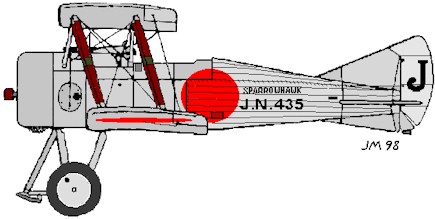The Sparrowhawk Ship Born Fighter Brief history of the Sparrowhawk Gloster aircraft's had in the beginning of the 1920:ies the production right for the Nieuport Nighthawk fighter. Gloster modified the Nieuport design and called the "new" fighter "Mars". The Gloster fighter was a two bay (four wing strut pairs) biplane powered by a 230 hp Bentley B.R.2 rotary engine and armed with two 7.7 mm machine guns. Gloster would further develop the Mars design into the successful Gamecock A fighter that later would be the base for a naval version that eventually was produced by Nakajima as the A1N Type 3 fighter. This was however a few years ahead of time and it was the Mars fighter that in 1921 was introduced by the British Sempill mission (30 British Navy instructors who during 18 month helped the Japanese Navy to train and develop it's airforce) to the Japanese Navy. The Japanese Navy purchased a total of 50 Mars fighters from Gloster and renamed the airplane "Sparrowhawk". Of the 50 Mars fighters, 30 became the Sparrowhawk I single seat shore based fighter, 10 the Sparrowhawk II two seat trainer and the remaining 10 the Sparrowhawk III single seat ship born fighter. An additional 40 Mars fighters were sold as parts and assembled at Yokosuka naval Air Arsenal becoming Sparrowhawk I's. The Sparrowhawk III Ship Born Fighter had been modified for Naval use by adding floatation equipment, arresting cable jaws on the wheel axle to grip the almost completed carrier Hosho's longitudinal (running from bow to stern) arresting cables and a hydrovane in front of the wheels to make emergency landings on water a little bit safer. The Navy's first ship born air group was formed around the 10 Sparrowhawk III's. The carrier Hosho was still not completed so flight training was started from a ramp that was built on one of the main turrents on the battleship Yamashiro. The Sparrowhawk III was however already replaced by the Mitsubishi 1MF Carrier Fighter before flight training could begin on the completed Hosho in 1923. The Sparrowhawk III was because of this not used for it's intended role on the Hosho but remained in service until 1928 flying from shore bases. Profiles The Sparrowhawk was most likely painted in a overall silver/grey color. The rudder is in many pictures seen lighter that the rest of the aircraft. The cabane and wheel struts had the same color as the fuselage while the wing struts were clear varnished wood. A dark, maybe olive, strengthening band was wrapped around the middle of the eight wing struts.
Hinomarus were from the beginning carried on the upper and lower wing surfaces. A large Hinomaru was soon added to both the fuselage sides just below the cockpit. A large black "J" for Japan was painted on the rudder and the name "SPARROWHAWK" was in painted in black across the fuselage side. Beneath the Sparrohawk name was the individual aircraft code painted also in black, e.g. J.N.430.
Both the Sparrowhawk III's above belonged to the Japanese Navy first carrier airgroup. They flew from the battleship Yamashiro in 1921 and 1922 while waiting for the Hosho to be completed. However, the Sparrowhawk would never serve on the carrier as the new Mitsubishi 1MF took it's place. Profile references
|

